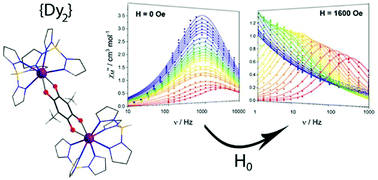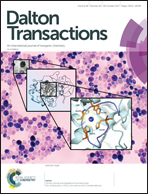Slow magnetisation relaxation in tetraoxolene-bridged rare earth complexes†
Abstract
Three families of tetraoxolene-bridged dinuclear rare earth (RE) complexes have been synthesised and characterised, with general formula [((HB(pz)3)2RE)2(μ-tetraoxolene)] (HB(pz)3− = hydrotris(pyrazolyl)borate; tetraoxolene = chloranilate (1-RE), the dianionic form of 2,5-dihydroxy-1,4-benzoquinone (2-RE), or its 3,6-dimethyl analogue (3-RE)). In each case, the bridging tetraoxolene ligand is in the diamagnetic dianionic form and species with selected lanthanoid(III) ions from Eu(III) to Yb(III) have been obtained, as well as the diamagnetic Y(III) analogues. Use of the 3,6-dimethyl substituted tetraoxolene ligand (Me2-dhbq2−) has also afforded the two byproducts [((HB(pz)3)(MeOH)(B(OMe)4)Y)2(μ-Me2dhbq)] (4-Y) and [{((HB(pz)3)(MeOH)Y)2(μ-B(OMe)4)}2(μ-Me2dhbq)2]Cl2 (5-Y), with the B(OMe)4− ligands arising from partial decomposition of HB(pz)3−. Electrochemical studies on the soluble 1-RE and 3-RE families indicate multiple tetraoxolene-based redox processes. Magnetochemical and EPR studies of 3-Gd indicate the negligible magnetic coupling between the two Gd(III) centres through the diamagnetic tetraoxolene bridge. Alternating current magnetic susceptibility studies of 1-Dy and 3-Dy reveal slow magnetic relaxation, with quantum tunnelling of the magnetisation (QTM) dominant in the absence of an applied dc field. The application of a dc field suppresses the QTM and relaxation data are consistent with an Orbach relaxation mechanism playing a major role in both cases, with effective energy barriers to magnetisation reversal determined as 47 and 24 K for 1-Dy and 3-Dy, respectively. The different dynamic magnetic behaviour evident for 1-Dy and 3-Dy arises from small differences in the local Dy(III) coordination environments, highlighting the subtle structural effects responsible for the electronic structure and resulting magnetic behaviour.



 Please wait while we load your content...
Please wait while we load your content...